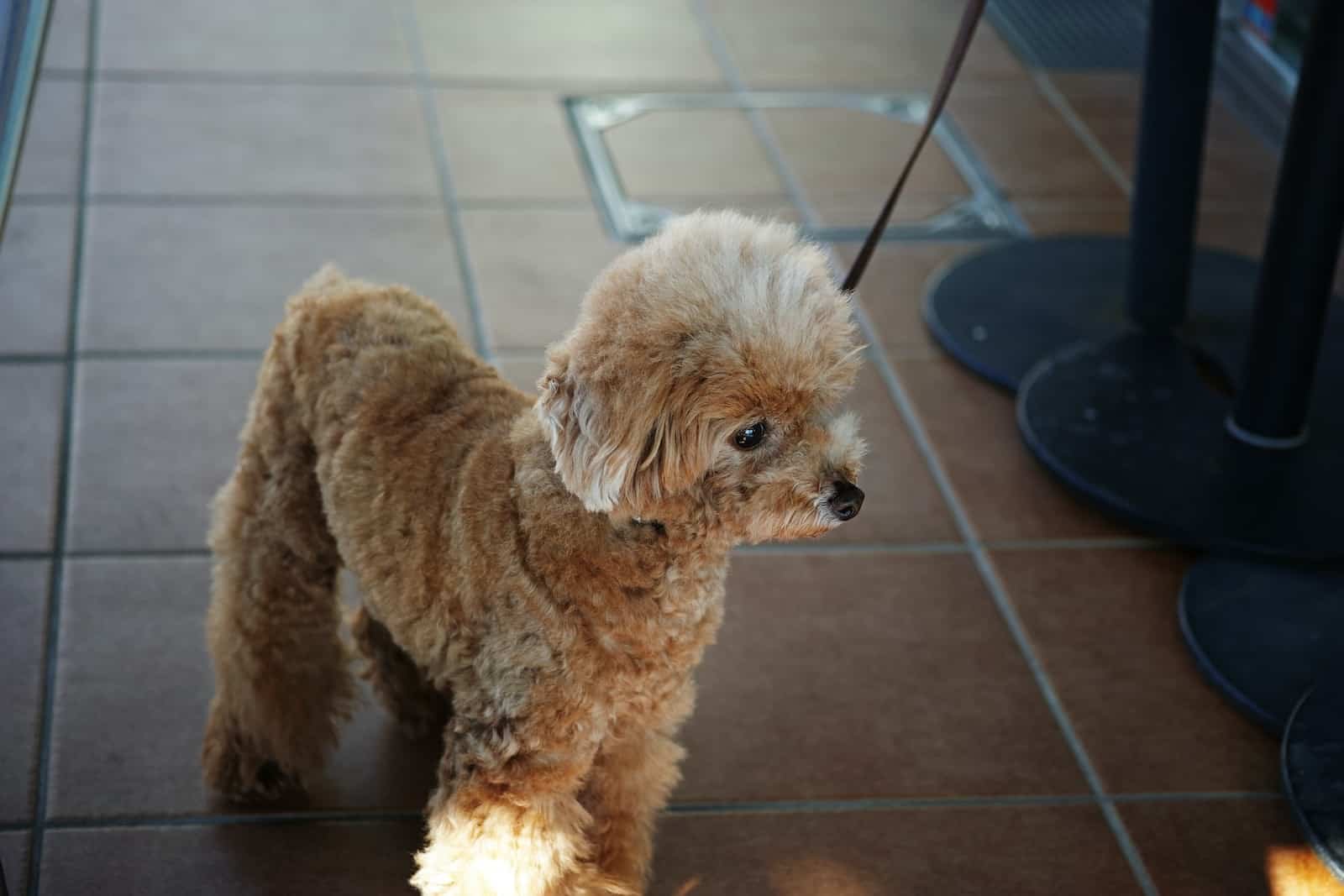
Understanding Dog Rescue and Adoption
Dog rescues step in to save dogs at risk—abandoned, abused, neglected, or surrendered. Shelters give these dogs a safe place and help them recover as they wait for new families.
What Is Dog Rescue?
Dog rescue means pulling dogs from unsafe situations. Rescues often take in homeless animals or those facing euthanasia in crowded shelters.
Most organizations run as nonprofits, relying on volunteers and donations. They provide medical care, foster homes, and help dogs learn to trust people again.
This process gets dogs ready for adoption and a shot at a better life. Rescues want every dog to have a real second chance.
The adoption process can get pretty detailed. Groups check if adopters are ready for the responsibility, sometimes with home visits or reference checks.
There’s usually an application and a fee, which supports the rescue’s work. You can dig into adoption fees and how nonprofits operate at Petful.
The Role Of Animal Shelters
Animal shelters play a huge part in dog rescue. They’re usually the first safe spot a stray or homeless dog finds.
Shelters give food, medical care, and a temporary home. Some are government-run, others are private charities.
A lot of them team up with rescues to help dogs that need extra care or struggle to get adopted. Shelters also try to reunite lost dogs with their owners.
But space and funding run tight. Sometimes, dogs can only stay for a short time before needing another placement.
By working with rescues, shelters can help more dogs and ease overcrowding. Local shelters often share lists of adoptable pets and run promotions—check GreaterGood for more.
Why Dogs Need Rescuing
So, why do so many dogs end up in rescue? Owners surrender pets for all kinds of reasons—life changes, money issues, or just not enough time.
Some dogs are abandoned or found wandering the streets. There’s also neglect and abuse, sadly.
Dogs from hoarding or poor living conditions may need extra patience and training before they’re ready for a new home. Overpopulation doesn’t help either.
There are just more dogs than homes in a lot of places, so shelters get crowded fast. This really shows why responsible ownership and spaying or neutering matter.
Rescuing a dog, especially one with a tough story, can be incredibly rewarding. Pets Haven talks more about that feeling.
How the Dog Adoption Process Works
Dog rescue adoption follows a set of steps to match each dog with a loving home. There’s paperwork, interviews, and agreements to make sure everyone’s ready.
Application and Screening Steps
If you want to adopt, you’ll start with an application. It covers personal info, your living situation, work hours, and past pet experience.
Rescues use this to figure out if you’re prepared for a safe and stable home. You can usually browse dogs available for adoption and mention your favorites.
Staff or volunteers review applications and might follow up by phone or email. They want to know your motivation and if everyone at home is on board.
References from a vet or landlord might come up. The goal is to place pets where they’ll be safe and wanted for good.
Strong applications show you’ve thought about the dog’s care and routine. This helps set everyone up for success.
Home Visit and Interviews
A home visit might be next. Someone from the rescue checks where the dog will live.
They look for hazards, check fences, and make sure the space is clean and safe. Staff may chat with family members and answer your questions.
They’ll talk about supplies you’ll need, like beds or crates. Sometimes, everyone living in the house needs to be present.
This helps the rescue feel confident the dog will be part of the family. If the home visit and interview go well, you’re almost there.
Finalizing Adoption With Contracts
If you’re approved, you’ll sign an adoption contract. This spells out your responsibilities, like providing medical care and returning the dog to the rescue if things don’t work out.
What’s usually in the contract:
- Pet’s name, breed, age
- Health records and microchip info
- Rescue’s policies, including possible follow-ups
Most rescues charge an adoption fee to cover costs. Staff will review the dog’s needs and answer last-minute questions.
Once you sign, your new dog is officially adopted and ready for home.
Choosing the Right Dog for Your Family
Picking the right dog is about more than looks. You’ve got to think about personality, breed traits, and how the dog fits into your daily life.
Assessing Personality and Temperament
A dog’s personality matters a lot. Spend time with the dog before adopting—see if it’s friendly, shy, active, or laid-back.
Meeting the dog at the shelter helps you see how it acts around adults, kids, and other pets. Some dogs love cuddles, others are all about playtime.
Ask the staff about the dog’s history and behavior. A dog that’s comfortable with lots of people will probably do better in a busy home.
If the dog seems nervous or scared, maybe a quieter environment is best.
Quick tips:
- Relaxed dogs suit families with young kids.
- Active dogs are great for older kids or teens.
- Ask if the dog has lived with other pets before.
Breed Considerations in Adoption
Different breeds need different care and energy levels. Labradors, for example, are friendly but need plenty of exercise.
Small breeds like the chihuahua can work for apartments but might need extra patience. Most rescue dogs are mixed breeds, so behavior can be a bit unpredictable.
Breed traits help, but personality is just as important. Think about how much shedding you can handle, barking tolerance, and what size fits your home.
If someone in the family has allergies, look for breeds that shed less.
Key points to watch:
- Allergies: Less shedding breeds are better if needed.
- Space: Big dogs need room.
- Time: Some breeds need more attention and training.
Matching With Household Needs
Every home has its own pace and space. Dogs need daily care—feeding, walks, play.
Puppies take extra time for training and socialization. Shelters can help you find a dog that fits your lifestyle.
If you’ve got young kids, a gentle, patient dog is probably best. Busy families might do better with an independent breed that doesn’t mind being alone.
Large, energetic dogs need a yard, while small or older dogs are often happy with short walks and indoor play. Take a good look at your family schedule before deciding.
More tips for choosing a family dog are at Pedigree’s guide on family dogs.
Key Qualities of Adoptable Dogs
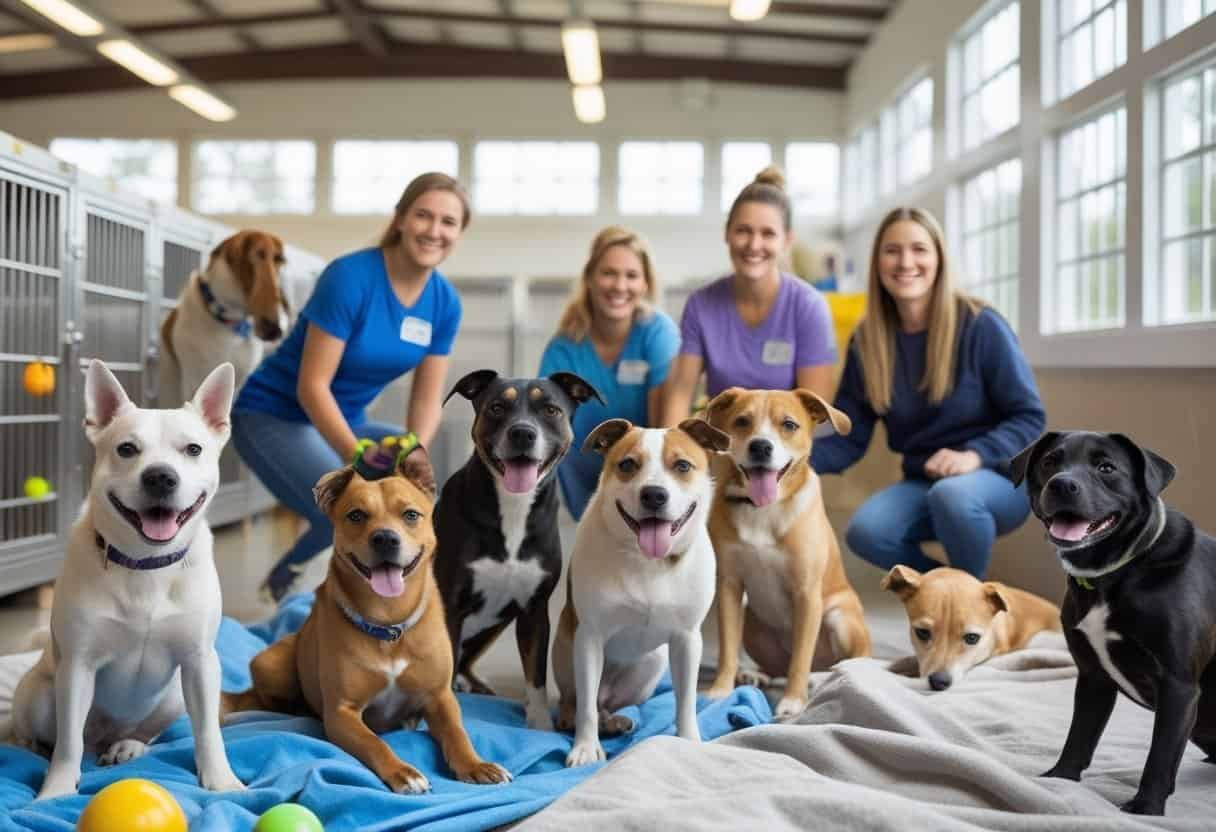
Adoptable dogs come with all sorts of backgrounds and personalities. Knowing what to look for can help you find a pet that fits your home.
Spayed and Neutered Status
Most rescues and shelters require dogs to be spayed or neutered before adoption. This keeps the pet population down and reduces health risks like certain cancers.
Spayed or neutered dogs usually have fewer unwanted behaviors—less roaming, less mounting. That makes things easier for new families.
Adopting a dog that’s already fixed saves you time and money, since these surgeries aren’t cheap. Some shelters cover these costs in the adoption fee, which is a nice bonus.
Good With Dogs and Cats
How a dog gets along with other animals matters, especially if you’ve already got pets. Many rescues test dogs with both dogs and cats before putting them up for adoption.
This helps avoid fights or stress at home. If you have other pets, ask if the rescue has checked the dog’s behavior with cats or dogs.
Some dogs are more social and thrive in multi-pet homes. It’s a good idea to arrange a meet-and-greet with your current pets if possible.
Most shelters allow this to make sure everyone gets along. Understanding how a rescue dog adapts to different situations is essential for a smoother move-in.
Dog Colors and Coat Types
Adoptable dogs come in all sorts of colors—brown, chocolate, white, yellow, tan, and fawn. Their coats can be short and smooth or long and curly.
Some folks have a favorite color or coat type, but honestly, looks don’t say much about a dog’s personality or health. It’s easy to get caught up in appearances, but that’s not what matters most.
Coat care needs can vary quite a bit. Long-haired dogs usually need more brushing to avoid mats.
Short-haired dogs are easier to groom, though they might shed more. It’s a bit of a trade-off.
Color can be a fun part of picking a rescue dog. Chocolate, fawn, or white coats can give each pup a distinct look.
Preparing Your Home for an Adopted Dog
Getting ready for a new dog means making your home safe and welcoming. Paying attention to little things can really help lower stress for everyone.
Home Safety and Pet-Proofing
Check every room for hazards before your new dog arrives. Kids’ toys, electric cords, and cleaning products should stay out of reach.
Dogs are curious and might chew on dangerous items. Food and medications for people can be toxic for dogs, so stash them in cabinets or high shelves.
Lock up trash cans or keep them behind closed doors. Coins, batteries, and buttons are risky if swallowed.
Baby gates can block off rooms or stairs until your dog learns the house rules. Some houseplants—like lilies or philodendrons—are surprisingly harmful if eaten.
A checklist can help you keep track:
| Item to Secure | Why It’s Important |
|---|---|
| Cleaning products | Toxic if ingested |
| Electrical cords | Chewing hazard |
| Trash cans | Source of unsafe food |
| Small objects | Choking or poison risk |
| Human medications | Possible poisoning |
For more detailed tips, check out this guide on preparing your home for a new rescue dog.
Setting Up a Comfortable Space
A loving home gives a dog a quiet, cozy spot to settle in. Pick a low-traffic corner of your living room or bedroom.
Set up a dog bed, blanket, or crate for comfort. Keep water and food bowls close, but not right next to the bed.
Some dogs feel safer in an open crate. Toss in a few toys to make the space welcoming.
Try to avoid loud noises or rushed introductions to other pets. Let your dog explore at its own pace.
Stick to the same spot for feeding and sleeping to help your dog build trust and routine. If you’ve got other pets, let them meet slowly and gently in this area.
Consistent care and respecting boundaries make a world of difference. For more on this, here’s advice for creating a safe and comfortable space.
Ongoing Care for Adopted Dogs
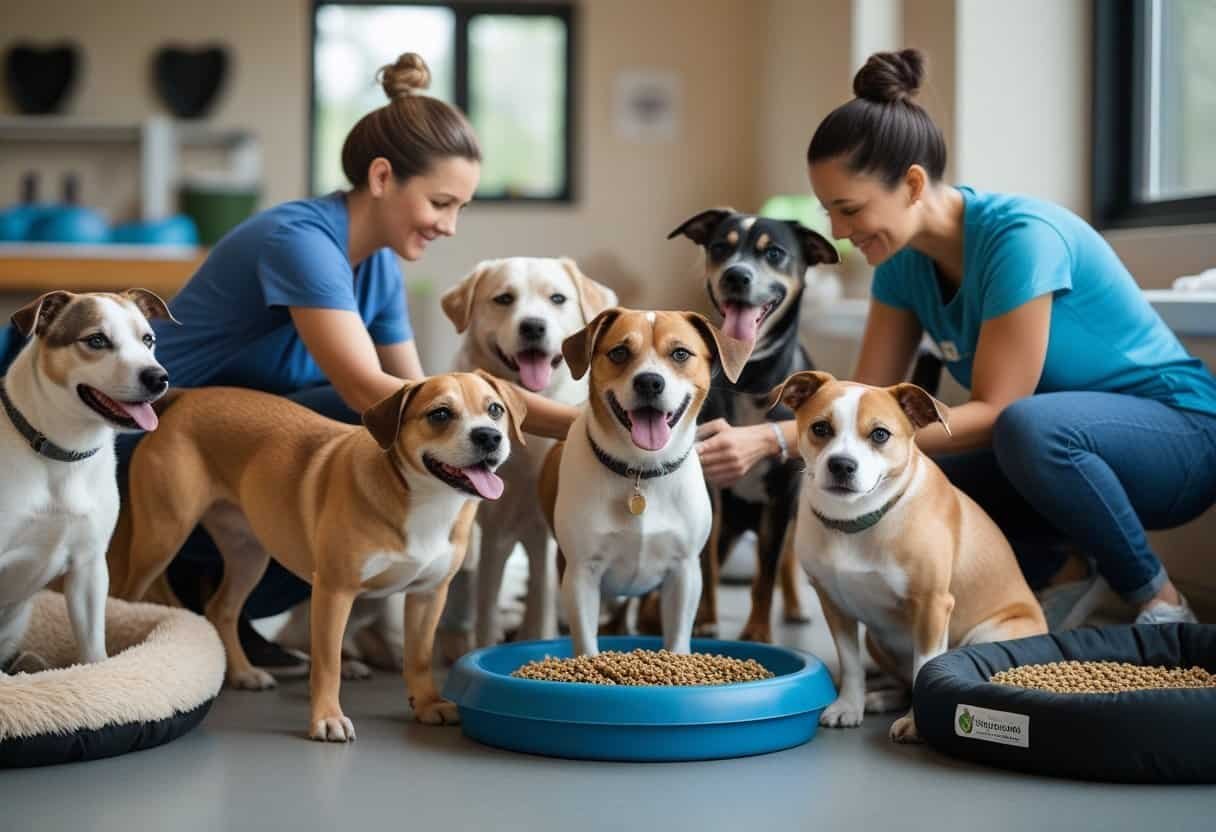
Regular care keeps adopted dogs healthy and happy. Sticking to routines helps dogs settle in and feel secure.
Health and Nutrition Essentials
Take your dog to the vet for regular checkups. Newly adopted dogs might need extra visits at first.
Vaccines, parasite control, and dental checks matter for long-term health. Feed high-quality food that matches your dog’s age and size.
Fresh water should always be available. If your dog’s appetite, energy, or behavior changes, that’s a sign to call the vet.
Exercise helps prevent obesity and keeps muscles strong. Daily walks, play, and mental stimulation are crucial.
Grooming—like baths, brushing, and nail trims—keeps skin and coats healthy. For more tips, check out first 30 days rescue dog care.
Training and Socialization
Short, positive training sessions work best. Teach basics like sit, stay, and come to keep your dog safe.
Use treats or praise to reward good behavior. Socialization helps dogs feel comfortable with people and other animals.
Introduce new faces and places slowly. Too many visitors or new situations at once can stress a dog out.
Patience is key. Some dogs need weeks or even months to build trust.
If you want more guidance, here’s an article on caring for an adopted rescue dog.
The Role of Volunteers and Fostering
Dog rescue groups rely on volunteers and foster caregivers. Volunteers handle daily care, while foster homes give dogs a safe place to land before permanent adoption.
Becoming a Rescue Volunteer
Rescue volunteers are the heart of day-to-day operations. They clean kennels, feed, walk, and socialize dogs.
Many also help at adoption events, introducing dogs to potential families. Some organize fundraisers or manage online adoption profiles.
New volunteers usually get training on animal safety and behavior. They learn the rescue’s rules and how to handle dogs with special needs or tough backgrounds.
This training helps keep everyone safe and gives dogs a better shot at a good home. Volunteers make a huge impact, especially when paid staff are stretched thin.
Want to know more? Here’s a breakdown of the crucial work of dog rescue volunteers.
Foster Care Programs
Foster care programs play a big role in a dog’s journey from rescue to adoption. Foster caregivers open their homes to dogs who need extra attention before they’re ready for a new family.
This kind of care lets dogs adjust to home life, learn manners, and recover from past trauma. Foster homes are usually less stressful than kennels, which helps shy or scared dogs come out of their shell.
Rescues provide fosters with food, bedding, and vet support. Foster providers keep the rescue updated on the dog’s progress and help find the right adopter.
Fostering frees up space in shelters, so rescues can help more dogs. For more, check out how foster families are unsung heroes in dog rescue and prepare dogs for adoption.
Transport Services in Dog Rescue
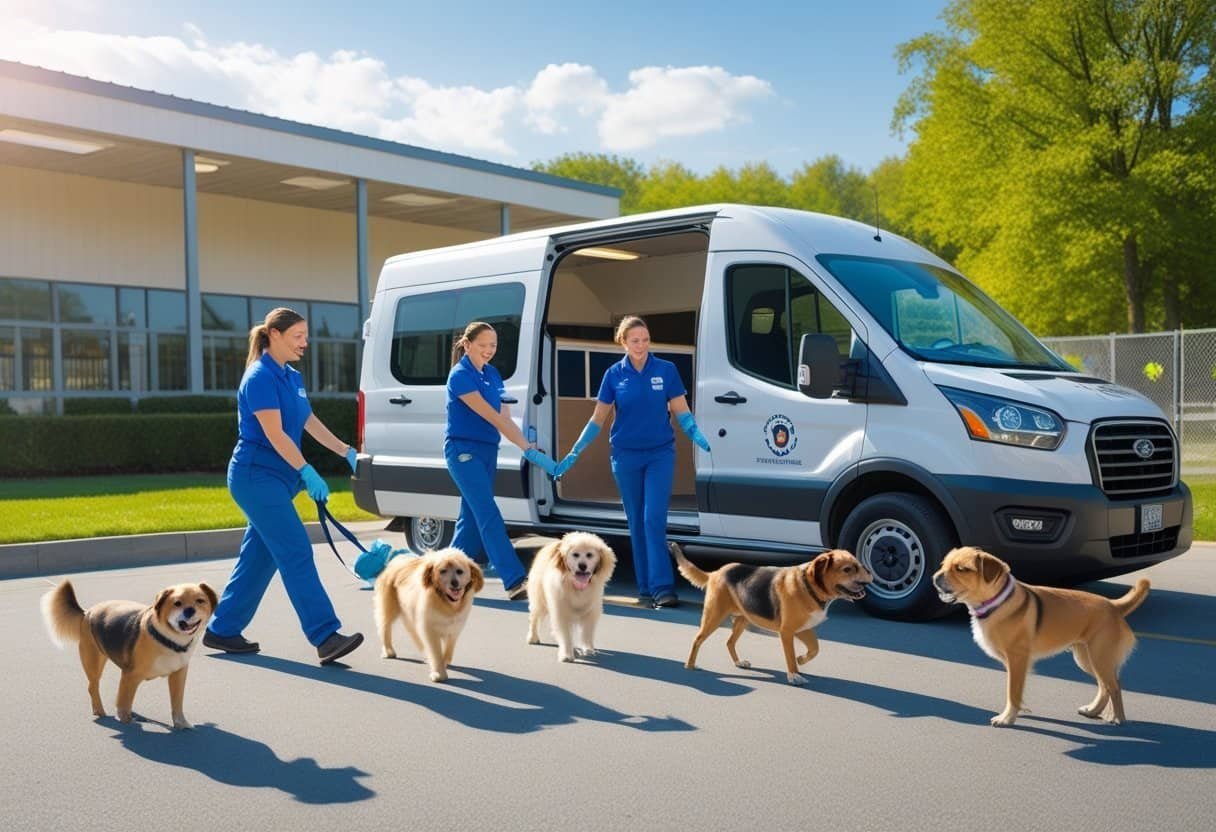
Dog rescue groups and shelters often need to move dogs from crowded or risky places to foster homes or adopters. Transport services help reduce the number of at-risk dogs in shelters and give them new chances in different areas.
How Dog Transportation Works
Dog transport usually uses vans, buses, or special vehicles to move several dogs at once. Rescues plan routes that can stretch hundreds or even thousands of miles.
Some organizations, like Rescue Riders, have teams that travel across the country. Volunteer networks might drive in relays, handing off dogs at planned stops.
Others, such as God’s Dogs Rescue, run weekly routes with their own vehicles, sometimes carrying dozens of dogs per trip.
Dogs ride in crates for safety and separation. Transport teams work with both sending and receiving shelters to handle paperwork and keep track of each dog on the journey.
Safety Protocols in Transit
Shelters and rescues stick to strict safety rules during transport. Dogs travel in clean, well-ventilated crates that are securely fastened.
Animals get food and water breaks on a set schedule. Drivers and volunteers watch each dog for stress or illness during the trip.
Vehicles have climate control to keep dogs comfortable, whether it’s hot or cold outside. Some groups, like Many Paws Volunteer Transport, plan routes with rest stops for exercise and cleaning.
Most rescues require dogs to see a vet and get up-to-date vaccines before travel. Each dog has ID and paperwork for safe and legal transfer between shelters or new homes.
Fundraising and Donations for Dog Rescues
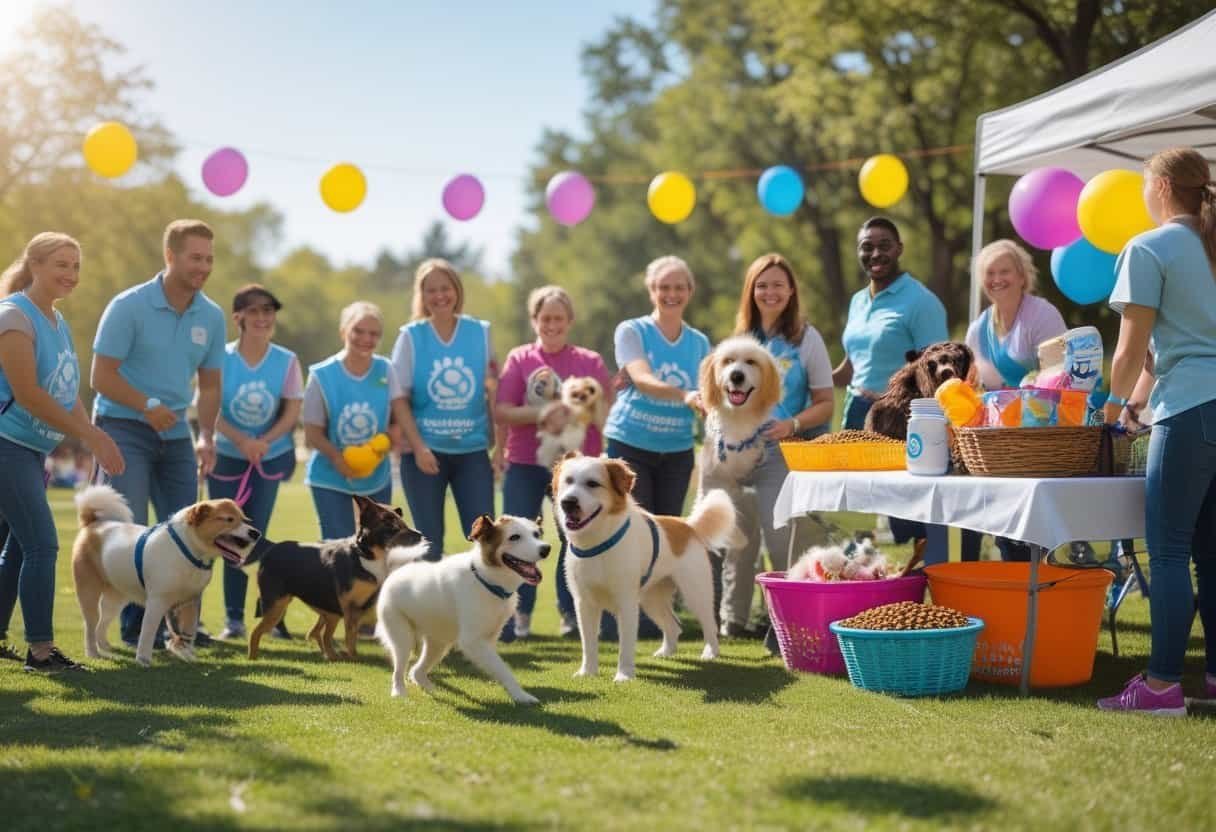
Dog rescues depend on steady donations and creative fundraising. These efforts help them save more animals, cover medical care, and find lasting homes.
Types of Donations Accepted
Dog rescues accept several kinds of donations. Money is the most common, whether it’s online, by check, or at events.
Some rescues offer monthly giving, memorial donations, or planned giving for folks who want to make a bigger impact. Donations aren’t just about cash, though.
Groups welcome dog food, treats, beds, crates, toys, and cleaning supplies. Services like vet care, grooming, or transport are also a big help.
Many rescues make donating easy with online fundraising pages. Others partner with local businesses or use wish lists so supporters can send items directly.
Larger rescues sometimes get sponsorships from businesses or individuals who want to fund a specific dog’s care.
Successful Fundraising Strategies
Dog rescues use all sorts of fundraising ideas to reach their goals. Charity walks, bake sales, and benefit dinners draw local crowds and raise both money and awareness.
Online campaigns help rescues reach supporters far and wide. Social media appeals and crowdfunding can spark quick support.
Lots of rescues apply for grants or get sponsorships from local businesses. Auctions and raffles—online or in person—are another fun way to raise money.
Some get creative with pet photo contests or themed donation days. If you’re curious, here are creative fundraising ideas for dog rescues.
Transparency matters too. Sharing updates and showing how donations are used keeps supporters coming back.
Support Networks for Adoptive Pet Owners
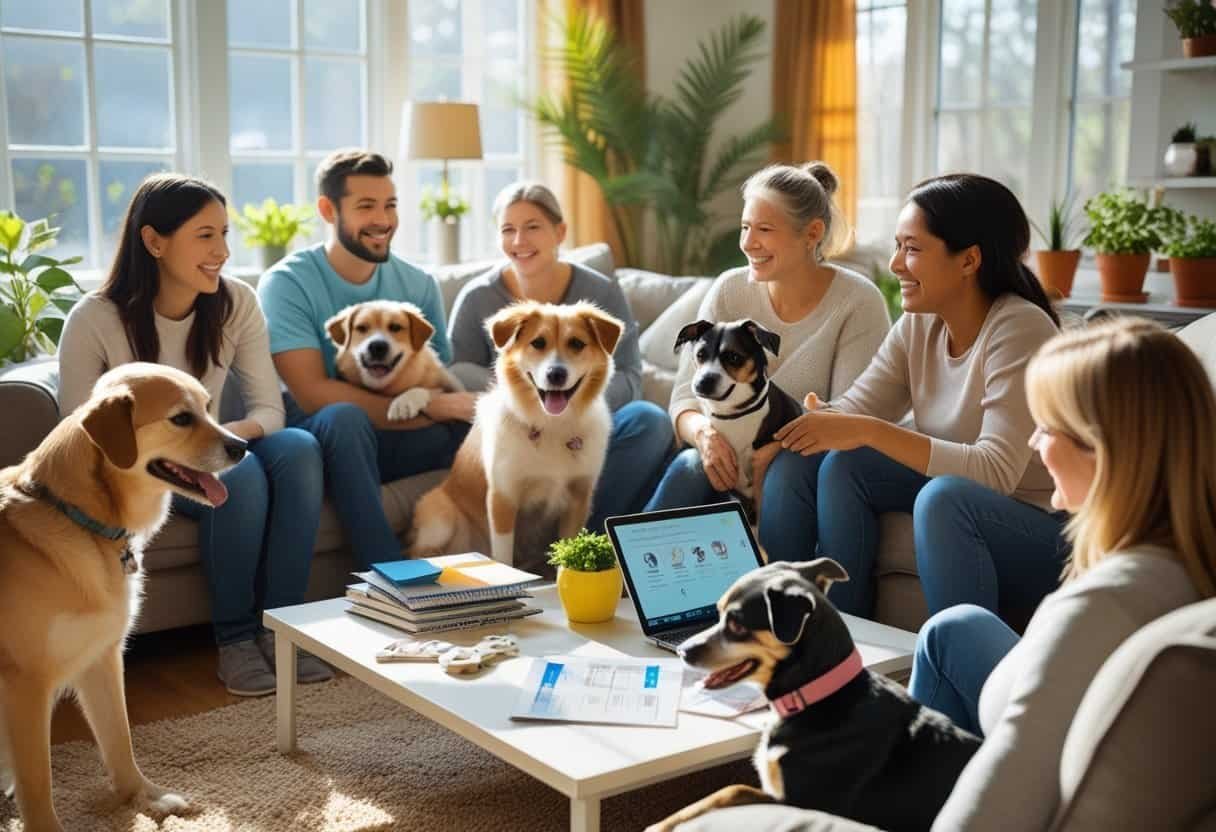
Support networks boost confidence for new dog owners. They connect people, share tips, and offer ongoing help with pet care.
Joining Dog Owner Communities
Dog owner communities are great for sharing advice and stories. Some groups meet in person, while others are online, so anyone can join.
Local animal shelters often suggest support groups for new pet owners. These groups help people adjust and feel less alone.
Online forums and social media groups are popular for fast answers to care questions. People often use them to find trainers or local vets.
The Best Friends Animal Society network links thousands of owners and animal welfare organizations. Some communities organize events, adoption fairs, and group training sessions.
Accessing Ongoing Resources
After adoption, owners sometimes need extra help with training or medical care. Many shelters offer free or low-cost resources like spay/neuter clinics and pet food banks.
Websites such as Petfinder list adoptable pets and provide educational materials. These resources cover nutrition, grooming, and health care basics.
Some organizations help when owners can’t keep their pets. They offer rehoming tools and advice.
Owner-to-owner adoption communities, like those on the ASPCA Pro website, connect people and reduce shelter crowding. This kind of support matters for both owners and dogs.
Common Myths About Dog Rescue Adoption

A lot of myths make people hesitate to adopt from a rescue. Misinformation about breeds and the process keeps dogs waiting longer for homes.
Debunking Breed Stereotypes
Some folks think certain rescue breeds are always dangerous or tough to handle. But honestly, behavior depends way more on training and environment than breed.
A shy or playful dog can come from anywhere, whether it’s a breeder or a shelter. Shelter staff check each dog’s behavior before adoption.
Families can ask about temperament, energy, or if the dog is good with kids. Most breeds in rescues are just as friendly and trainable as purebreds.
It’s just not fair to judge a dog by looks or breed alone. Some people worry breed mixes are unpredictable.
In reality, these dogs often have steady temperaments and adapt well. Staff work hard to match dogs and adopters for a good fit.
If you’re curious, here’s more on common myths about shelter dogs.
Clarifying Adoption Misconceptions
People sometimes think rescue dogs are untrainable, sick, or too old to learn. Most shelter dogs are healthy and eager to learn new things.
Rescues usually handle vaccinations, spaying/neutering, and vet checks before adoption. It’s not true that only puppies learn easily.
Older dogs can pick up basic commands, potty training, and even new tricks. Shelter staff offer advice and support during the transition home.
Another misconception? That “free” dogs from ads are a better deal. Dogs from shelters often have medical costs covered, making them safer and sometimes even cheaper.
You can read more about rescue adoption myths.
Frequently Asked Questions
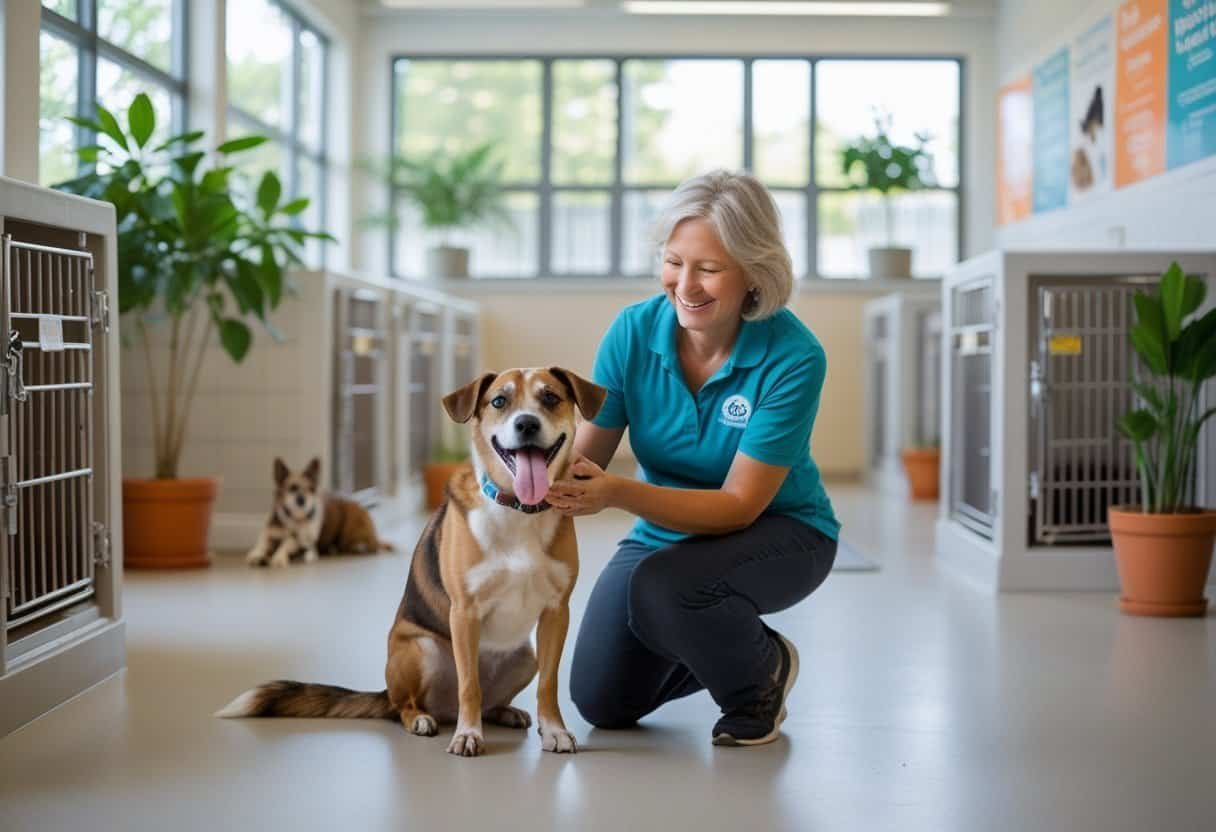
Dog rescue adoption takes a few important steps, from finding the right center to understanding costs and timing. It’s smart to know what to expect before and after adoption so you’re ready for a successful experience.
What steps should I take to adopt a rescue dog?
Start by researching rescue groups or shelters. Fill out an application and provide any requested info, like references or your pet experience.
Most shelters will want an interview, maybe a home visit, or a meet-and-greet with the dog. If you’re approved, you pay the fee and finish the paperwork.
How can I find dog rescue centers in my area?
Check local animal shelters, rescue groups, and humane societies first. Searching online for “dog rescue near me” works too.
Some organizations focus on certain breeds or sizes. Many groups keep updated lists of available dogs on their sites.
What are the common reasons some dogs are harder to adopt out?
Dogs with special needs, older dogs, or certain breeds can have a tougher time getting adopted. Sometimes it’s due to behavior or health issues.
Big dogs or breeds with bad reputations often wait longer. Shy or anxious dogs might need extra time to show their true personalities.
What is the average cost of adopting a dog from a rescue?
Adoption fees usually range from $50 to $500. The cost depends on the group, the dog’s age, and what’s included.
Most fees cover spay/neuter, vaccines, and microchips. Some rescues toss in starter supplies or basic training resources—see these essential questions.
Puppies and purebreds often cost more. Older dogs or those with medical needs might have lower fees.
How long does the adoption process usually take for a rescue dog?
It can take a few days to a couple of weeks. Some rescues move quickly, but things can slow down if they need to check references or do a home visit.
If several people want the same dog, the process might drag out. Usually, everything wraps up about a week after you’re approved.
What should I expect during the post-adoption period with a rescue dog?
Most dogs need a bit of time to settle into a new place. The “3-3-3 rule” gives you a rough idea: they might need three days just to decompress, three weeks to start feeling at home, and about three months before they really find their groove.
You’ll probably notice some changes in their behavior as they get used to everything. Just be patient. Keeping routines steady helps your new dog start to feel safe and part of the family.
If you want more advice, check out these key adjustment guidelines.





